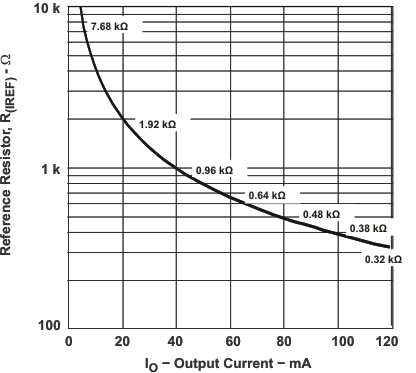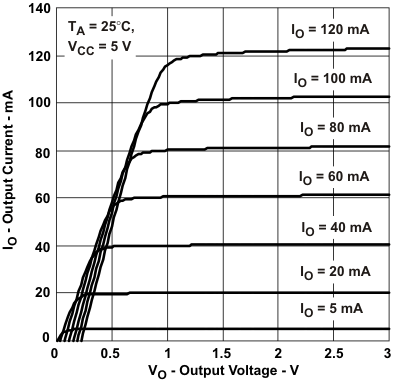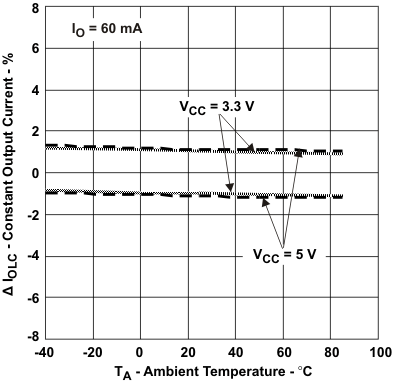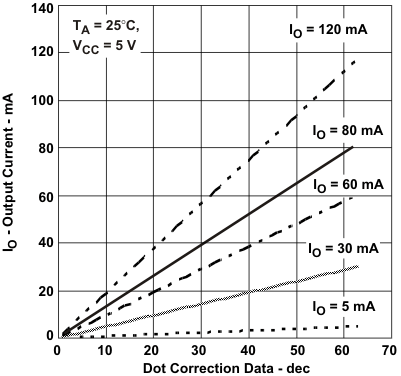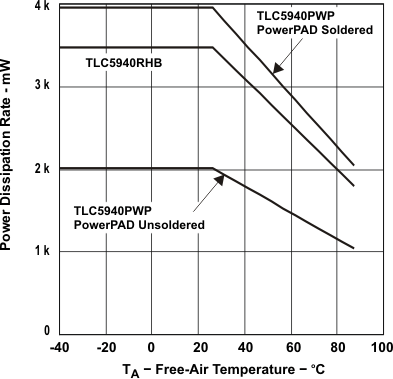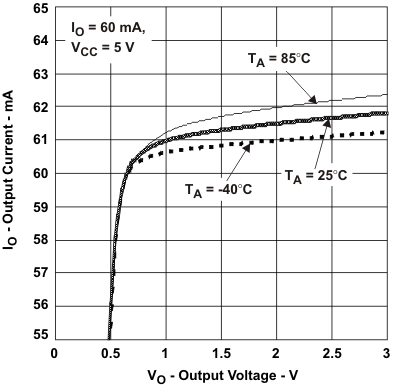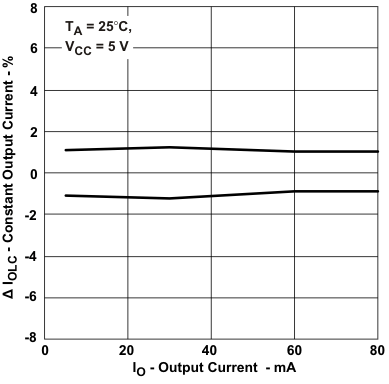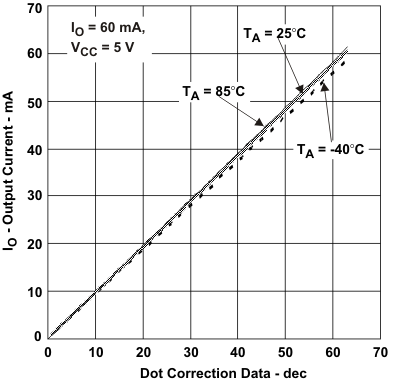SLVSA51E March 2010 – September 2016 TLC5940-EP
PRODUCTION DATA.
- 1 Features
- 2 Applications
- 3 Description
- 4 Revision History
- 5 Pin Configuration and Functions
- 6 Specifications
- 7 Parameter Measurement Information
- 8 Detailed Description
- 9 Application and Implementation
- 10Power Supply Recommendations
- 11Layout
- 12Device and Documentation Support
- 13Mechanical, Packaging, and Orderable Information
Package Options
Mechanical Data (Package|Pins)
Thermal pad, mechanical data (Package|Pins)
Orderable Information
6 Specifications
6.1 Absolute Maximum Ratings
over operating free-air temperature range (unless otherwise noted)(1) (2)| MIN | MAX | UNIT | |||
|---|---|---|---|---|---|
| Input voltage(3) | VCC | –0.3 | 6 | V | |
| V(BLANK), V(DCPRG), V(SCLK), V(XLAT), V(SIN), V(GSCLK), V(IREF) | –0.3 | VCC + 0.3 | V | ||
| Output voltage | V(SOUT), V(XERR) | –0.3 | VCC + 0.3 | V | |
| V(OUT0) to V(OUT15) | –0.3 | 18 | V | ||
| Output current (dc) | IO | 130 | mA | ||
| EEPROM program | V(VPRG) | –0.3 | 24 | V | |
| EEPROM write cycles | 25 | ||||
| Package thermal impedance | See Thermal Information | ||||
| Operating ambient temperature, TA | –40 | 125 | °C | ||
| Storage temperature, Tstg | –55 | 150 | °C | ||
(1) Stresses beyond those listed under Absolute Maximum Ratings may cause permanent damage to the device. These are stress ratings only, and functional operation of the device at these or any other conditions beyond those indicated under Recommended Operating Conditions is not implied. Exposure to absolute maximum rated conditions for extended periods may affect device reliability.
(2) Long-term high-temperature storage and/or extended use at maximum recommended operating conditions may result in a reduction of overall device life. See www.ti.com/ep_quality for additional information on enhanced plastic packaging.
(3) All voltage values are with respect to network ground terminal.
6.2 ESD Ratings
| VALUE | UNIT | |||
|---|---|---|---|---|
| V(ESD) | Electrostatic discharge | Human body model (HBM), per ANSI/ESDA/JEDEC JS-001, all pins(1) | ±2000 | V |
| Charged device model (CDM), per JEDEC specification JESD22-C101, all pins(2) | ±500 | |||
(1) JEDEC document JEP155 states that 500-V HBM allows safe manufacturing with a standard ESD control process.
(2) JEDEC document JEP157 states that 250-V CDM allows safe manufacturing with a standard ESD control process.
6.3 Recommended Operating Conditions
| MIN | NOM | MAX | UNIT | ||||
|---|---|---|---|---|---|---|---|
| DC CHARACTERISTICS | |||||||
| VCC | Supply Voltage | 3 | 5.5 | V | |||
| VO | Voltage applied to output (OUT0–OUT15) | 17 | V | ||||
| VIH | High-level input voltage | 0.8 VCC | VCC | V | |||
| VIL | Low-level input voltage | GND | 0.2 VCC | V | |||
| IOH | High-level output current | VCC = 5 V at SOUT | –1 | mA | |||
| IOL | Low-level output current | VCC = 5 V at SOUT | 1 | mA | |||
| IOLC | Constant output current | OUT0 to OUT15 | –40°C to 125°C | 72 | mA | ||
| –40°C to 85°C, VCC < 3.6 V | 60 | ||||||
| –40°C to 85°C, VCC > 3.6 V | 120 | ||||||
| V(VPRG) | EEPROM program voltage | 20 | 22 | 23 | V | ||
| TA | Operating free-air temperature | –40 | 125 | °C | |||
| AC CHARACTERISTICS (2) | |||||||
| f(SCLK) | Data shift clock frequency | SCLK | 30 | MHz | |||
| f(GSCLK) | Grayscale clock frequency | GSCLK | 30 | MHz | |||
| twh0/twl0 | SCLK pulse duration | SCLK = H/L (see Figure 12) | 16 | ns | |||
| twh1/twl1 | GSCLK pulse duration | GSCLK = H/L (see Figure 12) | 16 | ns | |||
| twh2 | XLAT pulse duration | XLAT = H (see Figure 12) | 20 | ns | |||
| twh3 | BLANK pulse duration | BLANK = H (see Figure 12) | 20 | ns | |||
| tsu0 | Setup time | SIN to SCLK ↑(1) (see Figure 12) | 5 | ns | |||
| tsu1 | SCLK ↓ to XLAT ↑ (see Figure 12) | 10 | ns | ||||
| tsu2 | VPRG ↑ ↓ to SCLK ↑ (see Figure 12) | 10 | ns | ||||
| tsu3 | VPRG ↑ ↓XLAT ↑ (see Figure 12) | 10 | ns | ||||
| tsu4 | BLANK ↓ to GSCLK ↑ (see Figure 12) | 10 | ns | ||||
| tsu5 | XLAT ↑ to GSCLK ↑ (see Figure 12) | 30 | ns | ||||
| tsu6 | VPRG ↑ to DCPRG ↑ (see Figure 17) | 1 | ms | ||||
| th0 | Hold time | SCLK ↑ to SIN (see Figure 12) | 3 | ns | |||
| th1 | XLAT ↓ to SCLK ↑ (see Figure 12) | 10 | ns | ||||
| th2 | SCLK ↑ to VPRG ↑ ↓ (see Figure 12) | 10 | ns | ||||
| th3 | XLAT ↓ to VPRG ↑ ↓ (see Figure 12) | 10 | ns | ||||
| th4 | GSCLK ↑ to BLANK ↑ (see Figure 12) | 10 | ns | ||||
| th5 | DCPRG ↓ to VPRG ↓ (see Figure 12) | 1 | ms | ||||
| tprog | Programming time for EEPROM (see Figure 17) | 20 | ms | ||||
(1) ↑ and ↓ indicates a rising edge, and a falling edge respectively.
(2) VCC = 3 V to 5.5 V, TA = –40°C to 125°C (unless otherwise noted)
6.4 Thermal Information
| THERMAL METRIC(1) | TLC5940-EP | UNIT | ||
|---|---|---|---|---|
| RHB (VQFN) | PWP (HTSSOP) | |||
| 32 PINS | 28 PINS | |||
| RθJA | Junction-to-ambient thermal resistance | 36.7 | 34.3 | °C/W |
| RθJC(top) | Junction-to-case (top) thermal resistance | 18.9 | 36.8 | °C/W |
| RθJB | Junction-to-board thermal resistance | 15.9 | 8.5 | °C/W |
| ψJT | Junction-to-top characterization parameter | 0.6 | 0.3 | °C/W |
| ψJB | Junction-to-board characterization parameter | 15.8 | 8.7 | °C/W |
| RθJC(bot) | Junction-to-case (bottom) thermal resistance | 2.3 | 1.6 | °C/W |
(1) For more information about traditional and new thermal metrics, see the Semiconductor and IC Package Thermal Metrics application report.
6.5 Electrical Characteristics
VCC = 3 V to 5.5 V, TA = –40°C to 125°C (unless otherwise noted)| PARAMETER | TEST CONDITIONS | MIN | TYP | MAX | UNIT | |
|---|---|---|---|---|---|---|
| VOH | High-level output voltage | IOH = –1 mA, SOUT | VCC –0.5 | V | ||
| VOL | Low-level output voltage | IOL = 1 mA, SOUT | 0.5 | V | ||
| II | Input current | VI = VCC or GND; BLANK, DCPRG, GSCLK, SCLK, SIN, XLAT | –1 | 1 | µA | |
| VI = GND; VPRG | –2 | 2 | ||||
| VI = VCC; VPRG | 50 | |||||
| VI = 21 V; VPRG; DCPRG = VCC | 4 | 10 | mA | |||
| ICC | Supply current | No data transfer, all output OFF, VO = 1 V, R(IREF) = 10 kΩ |
0.9 | 6 | mA | |
| No data transfer, all output OFF, VO = 1 V, R(IREF) = 1.3 kΩ |
5.2 | 12 | ||||
| Data transfer 30 MHz, all output ON, VO = 1 V, R(IREF) = 1.3 kΩ |
16 | |||||
| Data transfer 30 MHz, all output ON, VO = 1 V, R(IREF) = 640 Ω |
30 | |||||
| IO(LC) | Constant sink current (see Figure 10) | All output ON, VO = 1 V, R(IREF) = 640 Ω, 25°C | 54 | 61 | 69 | mA |
| All output ON, VO = 1 V, R(IREF) = 640 Ω, Full temperature | 42 | 61 | 72 | |||
| Ilkg | Leakage output current | All output OFF, VO = 15 V, R(IREF) = 640 Ω, OUT0 to OUT15 |
±1 | µA | ||
| ΔIO(LC0) | Constant sink current error (see Figure 10) | All output ON, VO = 1 V, R(IREF) = 640 Ω, OUT0 to OUT15, 25°C |
±4% | |||
| All output ON, VO = 1 V, R(IREF) = 640 Ω, OUT0 to OUT15(1), Full temperature |
±12% | |||||
| All output ON, VO = 1 V, R(IREF) = 1300 Ω, OUT0 to OUT15, 25°C |
±4% | |||||
| All output ON, VO = 1 V, R(IREF) = 1300 Ω, OUT0 to OUT15(1), Full temperature |
±8% | |||||
| ΔIO(LC1) | Constant sink current error (see Figure 10) | Device to device, Averaged current from OUT0 to OUT15, R(IREF) = 1920 Ω (20 mA)(2) | –2% | |||
| 0.4% | ||||||
| ΔIO(LC2) | Constant sink current error (see Figure 10) | Device to device, Averaged current from OUT0 to OUT15, R(IREF) = 480 Ω (80 mA)(2) | –2.7% | |||
| 2% | ||||||
| ΔIO(LC3) | Line regulation (see Figure 10) | All output ON, VO = 1 V, R(IREF) = 640 Ω OUT0 to OUT15(3), 25°C |
±4 | %/V | ||
| All output ON, VO = 1 V, R(IREF) = 640 Ω OUT0 to OUT15(3), Full temperature |
±11 | |||||
| All output ON, VO = 1 V, R(IREF) = 1300 Ω , OUT0 to OUT15(3), 25°C |
±4 | |||||
| All output ON, VO = 1 V, R(IREF) = 1300 Ω, OUT0 to OUT15(3), Full temperature |
±4 | |||||
| ΔIO(LC4) | Load regulation (see Figure 10) | All output ON, VO = 1 V to 3 V, R(IREF) = 640 Ω, OUT0 to OUT15(4), 25°C |
±6 | %/V | ||
| All output ON, VO = 1 V to 3 V, R(IREF) = 640 Ω, OUT0 to OUT15(4), Full temperature |
±20 | |||||
| All output ON, VO = 1 V to 3 V, R(IREF) = 1300 Ω, OUT0 to OUT15(4), 25°C |
±6 | |||||
| All output ON, VO = 1 V to 3 V, R(IREF) = 1300 Ω, OUT0 to OUT15(4), Full temperature |
±6 | |||||
| T(TEF) | Thermal error flag threshold | Junction temperature(5) | 150 | 170 | °C | |
| V(LED) | LED open detection threshold | 0.3 | 0.4 | V | ||
| V(IREF) | Reference voltage output |
R(IREF) = 640 Ω | 1.2 | 1.24 | 1.28 | V |
(1) The deviation of each output from the average of OUT0-15 constant current. It is calculated by Equation 1.
(2) The deviation of average of OUT1-15 constant current from the ideal constant-current value. It is calculated by Equation 2. The ideal current is calculated by Equation 3.
(3) The line regulation is calculated by Equation 4.
(4) The load regulation is calculated by Equation 5.
(5) Not tested. Specified by design
6.6 Switching Characteristics
VCC = 3 V to 5.5 V, TA = –40°C to 125°C (unless otherwise noted)| PARAMETER | TEST CONDITIONS | MIN | TYP | MAX | UNIT | |
|---|---|---|---|---|---|---|
| tr0 | Rise time | SOUT | 16 | ns | ||
| tr1 | OUTn, VCC = 5 V, TA = 60°C, DCn = 3 Fh | 10 | 30 | |||
| tf0 | Fall time | SOUT | 16 | ns | ||
| tf1 | OUTn, VCC = 5 V, TA = 60°C, DCn = 3 Fh | 10 | 30 | |||
| tpd0 | Propagation delay time | SCLK to SOUT (see Figure 12) | 30 | ns | ||
| tpd1 | BLANK to OUT0 | 60 | ns | |||
| tpd2 | OUTn to XERR (see Figure 12 ) | 1000 | ns | |||
| tpd3 | GSCLK to OUT0 (see Figure 12 ) | 60 | ns | |||
| tpd4 | XLAT to IOUT (dot correction) (see Figure 12 ) | 60 | ns | |||
| tpd5 | DCPRG to OUT0 (see Figure 12) | 30 | ns | |||
| td | Output delay time | OUTn to OUT(n+1) (see Figure 12 ) | 20 | 30 | ns | |
| ton-err | Output on-time error | touton– Tgsclk (see Figure 12), GSn = 01 h, GSCLK = 11 MHz | 10 | –50 | –90 | ns |
6.7 Typical Characteristics
